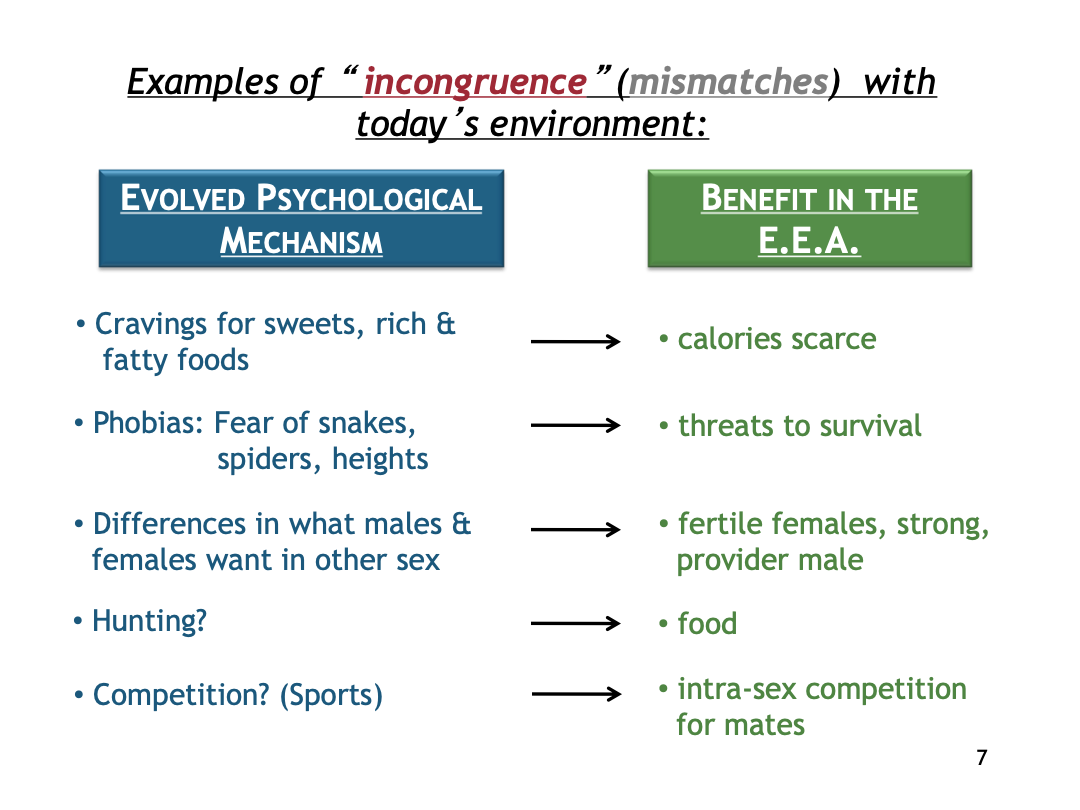Animal Behaviour - Final
Parental Care and Social Behaviour
Parental care questions are answered by weighing cost vs. benefits. Why are those questions important. What are the costs vs. benefits of parental care? Most species have 0 parental care.
Signal of need hypothesis: birds beg enough cuz they need it the most
Signal of quality hypothesis: feeding the highest quality offspring based of signal or merit
Sexual conflict over parental care - Frigate Bird
Female-only frigatebirds birds typically raise for longer. They have less feeding than two males.
Parental care is behaviour by parent which increases offspring’s fitness that would not occur in absence of offspring.
Modes of parental care are feeding, protection, transportation, maintenance (grooming, heat, gas exchange, defense against disease, etc.), and teaching.
There are different ways of group, different parental units and amount of kids.
Altricial young: this is important because some species may not know how to feed themselves. This is especially common in bird, canines, felines, and primates.
Precocial young: animals that lay eggs and never see them again, young never see parent, how do they grow up to know how to do things.

Environments where you see parental care or no parental care:
K-selection: constant, predictable environments. Individuals are larger, longer lifespan - populations at capacity. Selection pressure - intense INTRAspecific competition. The strategy is to use quality offspring and less. Few, but well-prepared offspring - strength, knowledge, etc. There is parental care. High benefit.
r-selection: uncertain, variable environment. Low survivorship, short lifespan. Selection pressure - unpredictable environment, predation. Strategy is quantity (many cheap offspring, some will survive by chance alone). Little or no parental care. Low benefit.
No parental care: Many invertebrates, some fish, reptiles & amphibians.
Uniparental care: (usually female) Many mammals, some invertebrates, fish, reptiles, amphibians & birds. Many of the fish have only males.
Biparental care: Many birds, some mammals, few fish
William’s principal: investment in the present comes at the cost of investment in the future. Lifetime reproductive success (LRS) depends on…
Present success (P): P is a function of what you are giving to your present offspring, Product of reproductive effort.
Future success (F): F is a function of what you have to give you future offspring (your own growth and survival). Product of somatic effort.
LRS = P(RE) + F(SE)
They aren’t always trying to maximize lifetime success. Future success is what you have to offer future offspring.
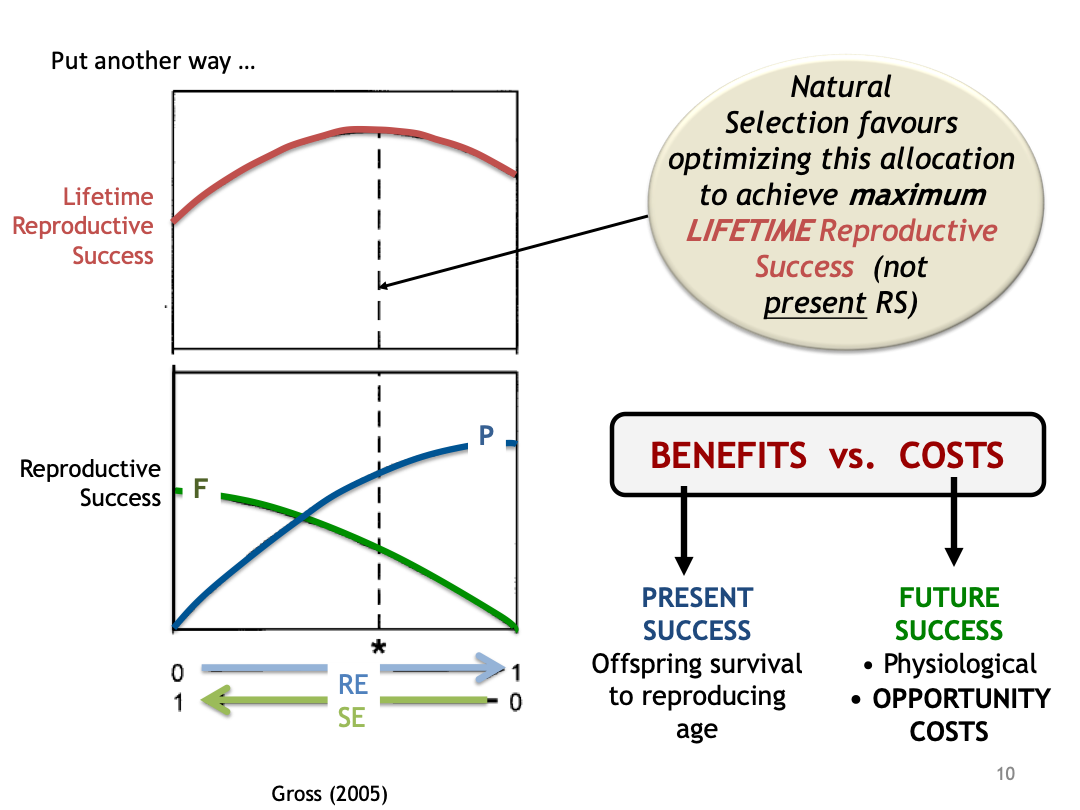
As you increase present efforts, future decreases. Lifetime peak when sum is highest. Add two bars - where do you see the max reproductive success.
Natural selection favours optimizing care allocation to achieve maximum lifetime reproductive success.
Trivers-Willard Hypothesis:
If you’re of high rank, you’re going to produce good sons. Good males are more likely to bring in massive amounts of kinds. Might as well have a son, they’ll get more grandkids.
Low social rank: you’re going to have offspring that are not highest ranking, better to play it safe and have daughters. They won’t give you as many, but they’re pretty likely to give you something.
No one knows how this is controlled - could be hormones.
Higher mother social rank = more % of male offspring
Differential allocation of parental care in response to sexy mate with good genes by female blue tits
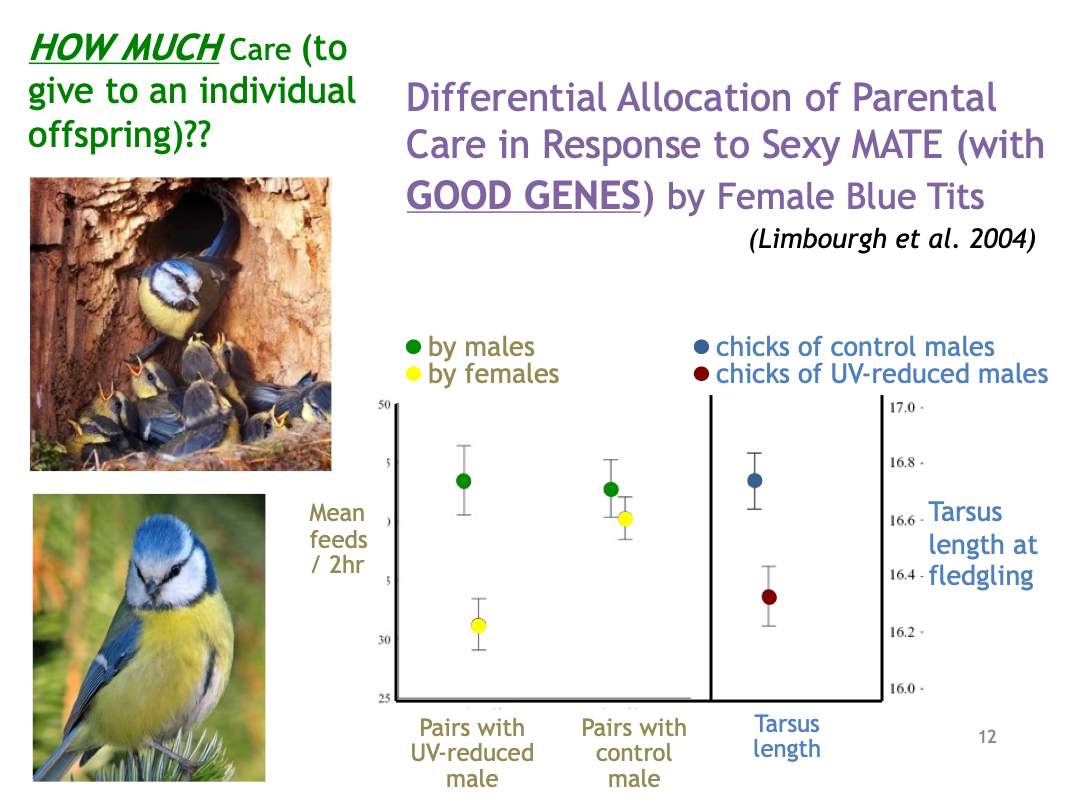
Limbourgh et al
Fluorescent blue patch reflecting UV light - those individuals of brightest patch are thought to have good genes (immune systems). 2 conditions - males with similar patch colour. They darkened the patch on males or they left the male the same.
Chicks of control males - bigger tarsus length. Given as how big the bird is, larger chicks out of them.
Chicks of darkened males - smaller chicks.
We can’t say it’s good genes, because genes should be the same, females who preferentially fed the chick of bright headed birds rather than dark headed birds - only changing how good the female perceived the males to be. Females feed good male’s kids more because they like their genes.
Parental Investment Theory (P.I.): Anything done by the parent for the offspring that increases the offspring’s chance of surviving while decreasing the parent’s ability to invest other offspring. r x b > c → Hamilton’s rule. Benefits are in terms of current offspring and not giving to future offspring.
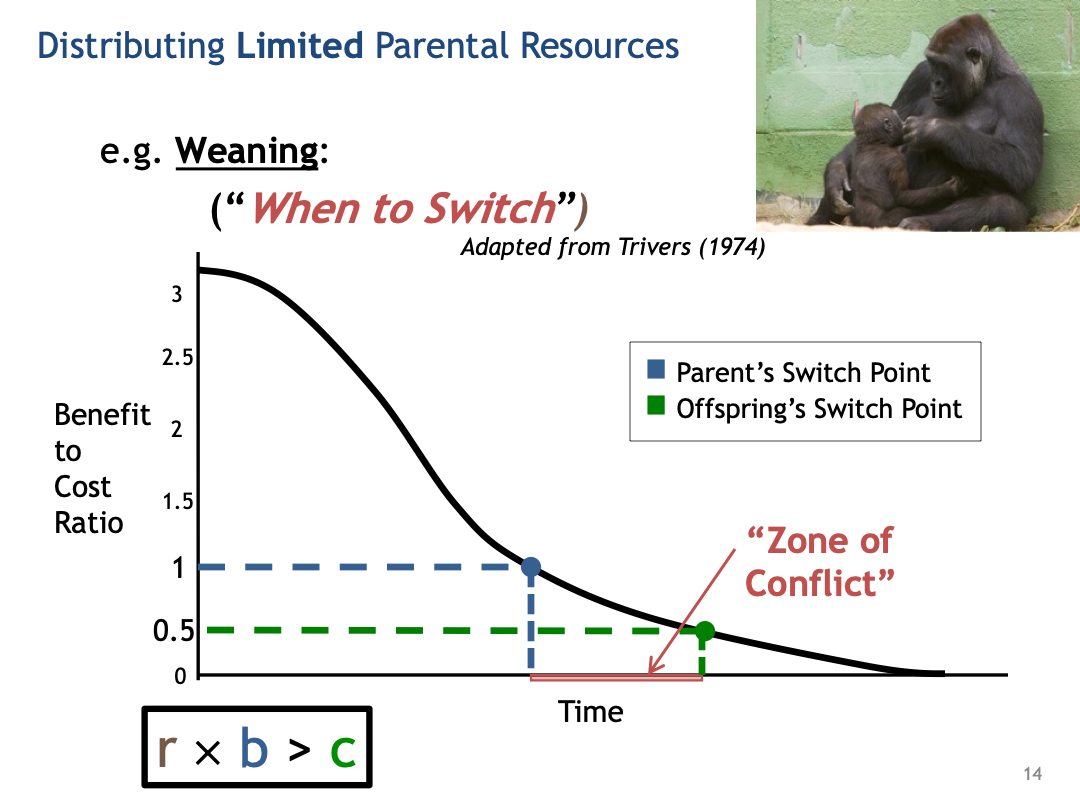
When to switch - stop weaning. When to stop providing breastmilk to present offspring. Overtime - very young, you need mother’s milk, older you get less you need. Present offspring can have their own food. Mother can keep feeding present offspring until ratio is 1:1. Present offspring - yes you want more to switch, because next sibling is related to you, but really you want her to give much more to you. I’m okay with giving up. 100% as related to yourself, vs. half of a sibling. When your mother wants to switch and you don’t yet - that’s called the zone of conflict.
Parent-offspring conflict: the clash of interests that occurs when parents can gain fitness by withholding parental care or resources from some offspring in order to invest in another round of reproduction at a time when existing offspring would benefit from receipt of the investment → Sibling-rivalry.
Offspring-offspring conflict. Because their chicks hatch asynchronously - a different chick hatches everyday. Difference in birth order.
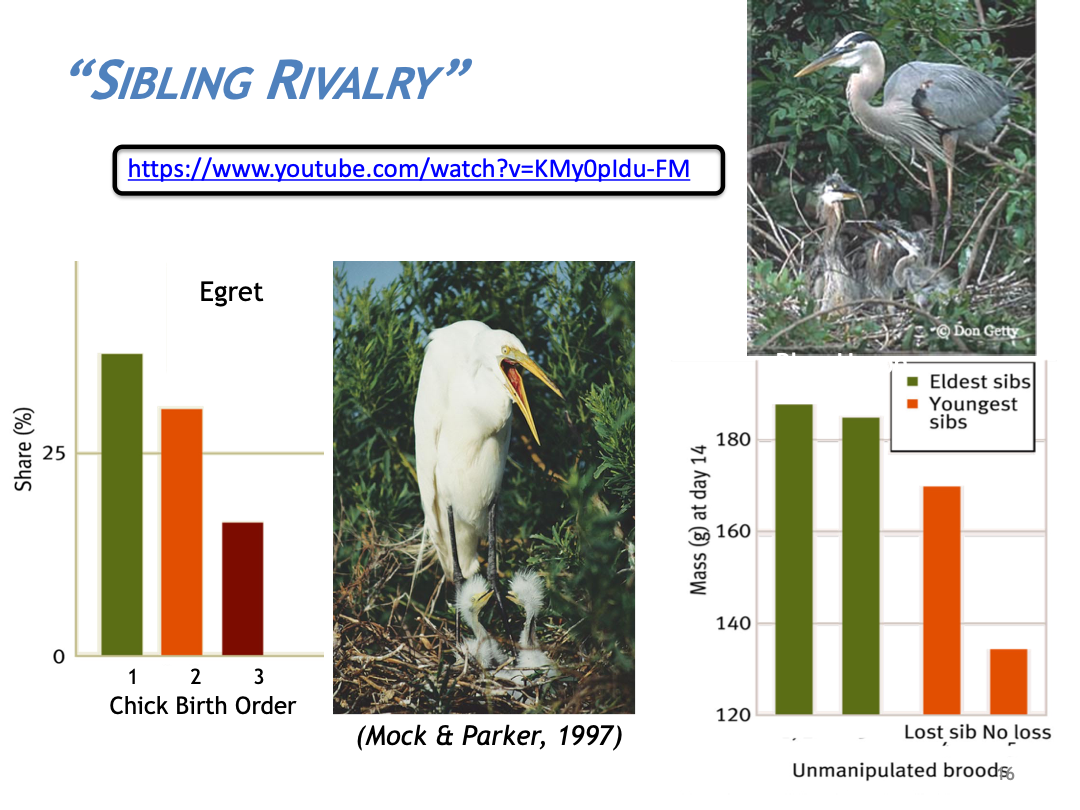
Size difference - difference when young are begging for food, goes to tallest begging (oldest chick), youngest gets least amount, size difference becomes bigger and bigger. How big they are when 4th chick is not lost. How is the 4th chick lost - kill it, throw it out the nest.
Siblicide: Parents don’t have the resources for all those siblings anyway, maybe it’s best if it dies. Is it up to the chicks, or do the parents encourage it.
Cross-fostering experiment: we see parents tend to control siblical behaviour.
Siblicidal Mom + Offspring - 100% of early siblicide
Siblicidal Mom + BFB - 80% of early siblicide
BFB + Siblicidal Offspring - 40% of early siblicide
BFB+BFB = 0% of early siblicide
Offspring recognition: Some species - parents can recognize offspring, some cannot. 3000 penguins with fish and they all look the same. Males and offspring look the same - they do an identity parade, and she makes her way down the line, eventually the father will recognize her unique call. Animals can recognize their young when there is a need to (black headed gulls). No need - they just assume what’s in their nest is their young.
Brood parasitism: when animals exploit parental care of individuals other than their parents. Dumps eggs on a second host species to take care of their young, because it relies on species inability to recognize young. Cuckoo and cowbirds don’t have the ability (rule of thumb). Can’t recognize these big eggs.
Cowbirds egg is bigger than warbler egg.
Non-obligate: lays eggs in own and conspecific nests
Obligate: has completely lost the ability to build nest or incubate eggs
Arm’s race - host eggs moving away from parasite eggs. Preferentially breeding different looking egg - that’s how selection effort works.
The evolution of social behaviour has developed between kin and non-kin. There are social species and solitary species. Packs fish, insects, mammals.
Cost
Competition for food and mates - female aggression of matings in red deer. 2 female red deer who are fighting over mates. A group and they’re foraging, a certain level of aggression. If they’re in a harem, they’re less aggressive, but an oestrous group is aggressive and more desperate if the situation were to present itself.
Energy and time of dominance interactions - Fed swordtail, good food in beginning and end, fed swordtail bad food and then good food. Aggressive behaviour in a good-good group because they have more energy to be aggressive, dominance interactions, they can win cuz they were fed more. Requires energy to be winning, another cost of living.
Disease - parasitic infection. Parasitoid wasps - would expect females to live in places with least infected wasps. Lifetime reproductive success compared to colony size - 50 is peak.
Risk of brood parasitism
Conspicuousness - More obvious if you’re all together. Competition over reproduction - could be victim of egg removal or ovicide (victims of egg removal lay more eggs and yield less young).
Benefits
Dealing with the physical environment - protection. Making characteristic sounds. Parents feeding their offspring. Difference between whether there’s 4 birds in a cavity or what. Temperature difference when something is occupied or not occupied. Greater than 4 degree temperature difference. A lot of individuals live socially.
Information - Groups of the cliffs. Follow individuals who come back with food. Not successful of first trip, become follower on second trip.
Protection - California Ground Squirrels. They live in colonies on the ground, they protect each other from predators like snakes.
Territory Defense
Predation - dilution effect (nearest-neighbour distance affects vigilance behaviour) or many eyes effect (increased detection - would lead to alarm calling).
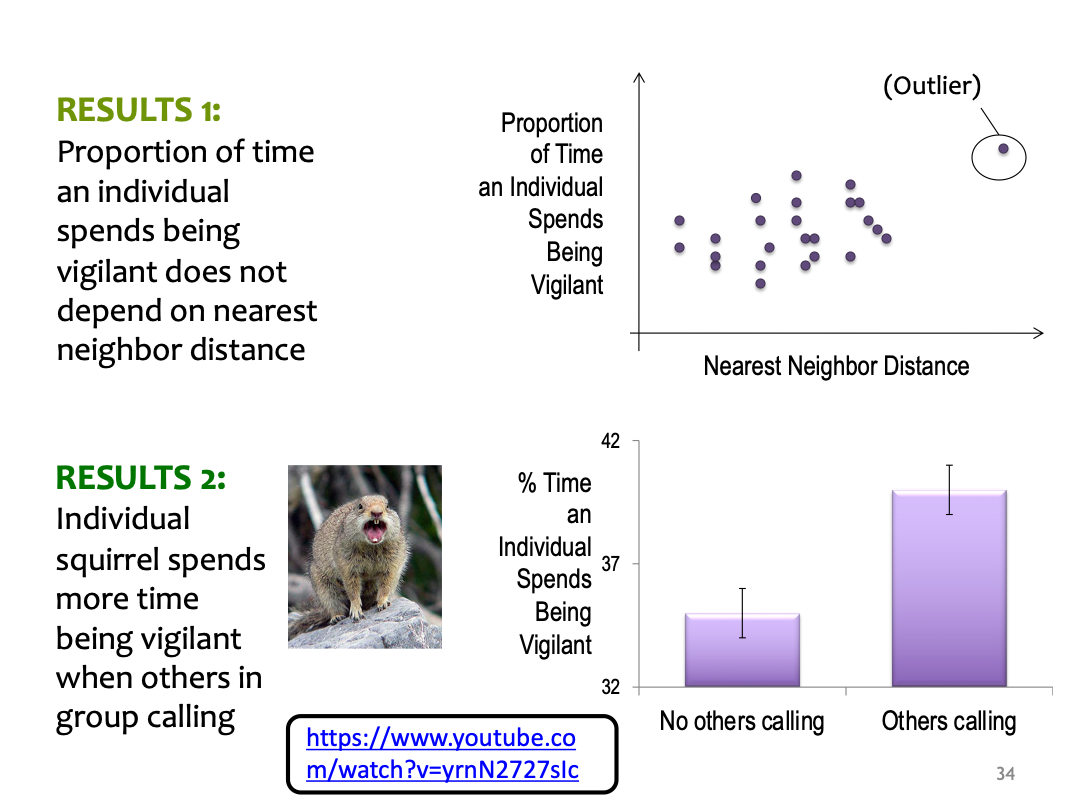
Peeping: others stop what they are doing and suddenly look up and be vigilant. Does NOT depend on nearest neighbour (no sounding off). Squirrel spends more time being vigilant when others are in group calling. Group eyes spend less time being vigilant overall, they’re only doing it really when someone is calling.
Cooperative hunting: benefits outweigh the costs. Hyena kills and wolf pack. Best to have something instead of nothing. Obtain food so you gon’t get obtained.
Territory defense and predation require cooperation, while the others can arise from individuals being selfish. These arrive from individuals being selfish. Each using other as shield from environment. Doesn’t involve teaching, selfish behaviours, some thing require cooperation. It increases overall fitness.
Cooperation = benefit self (and cost to self) + benefit of other.
We can define fitness by the benefit to self via self and via kin. Through yourself or through others that are related to you.
Benefit to self via self
Immediate / mutualism
The benefit to oneself is immediate
Interspecific
Ants will protect butterfly larvae or pupae nectar, while butterflies help them
Butterfly secretes honeydew that attracts ants, and ants protect the butterfly larvae
Weight higher when ants aren’t around. Less energy goes towards growth, less sugary solution. Attracted more ants when they were stridulating than when they weren’t. They called the ants to them.
Eel left the area and swam away together. They hunt together. Two ways of signaling. Shakes head → come on, let’s hunt.
Future / reciprocal altruism
Expected to evolve in species where individuals are intelligent, long lived, living in small groups, and have repeated interactions
Prisoner’s Dilemma: rational choice for each player is to defect, but both would do worse if both defected than if both cooperated.
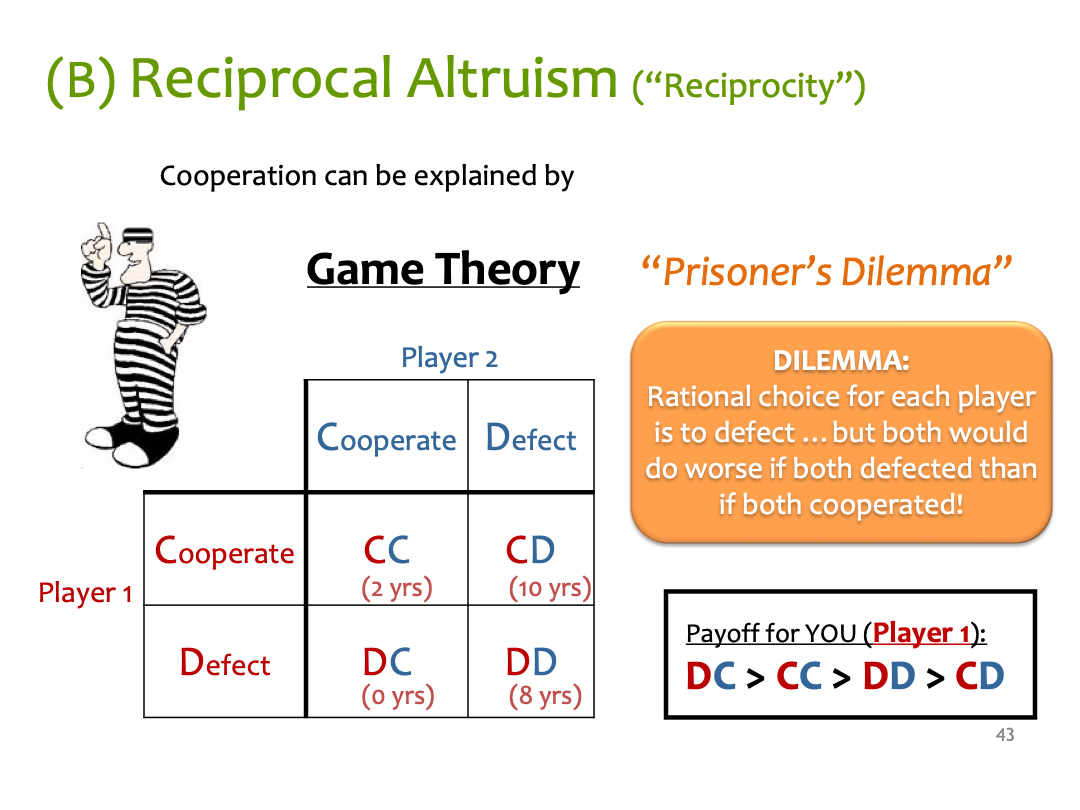
Cooperative predator inspection in guppies - Two lone individuals inspect. Take time being in front, leap-frogging. Being in the front is the most vulnerable position.
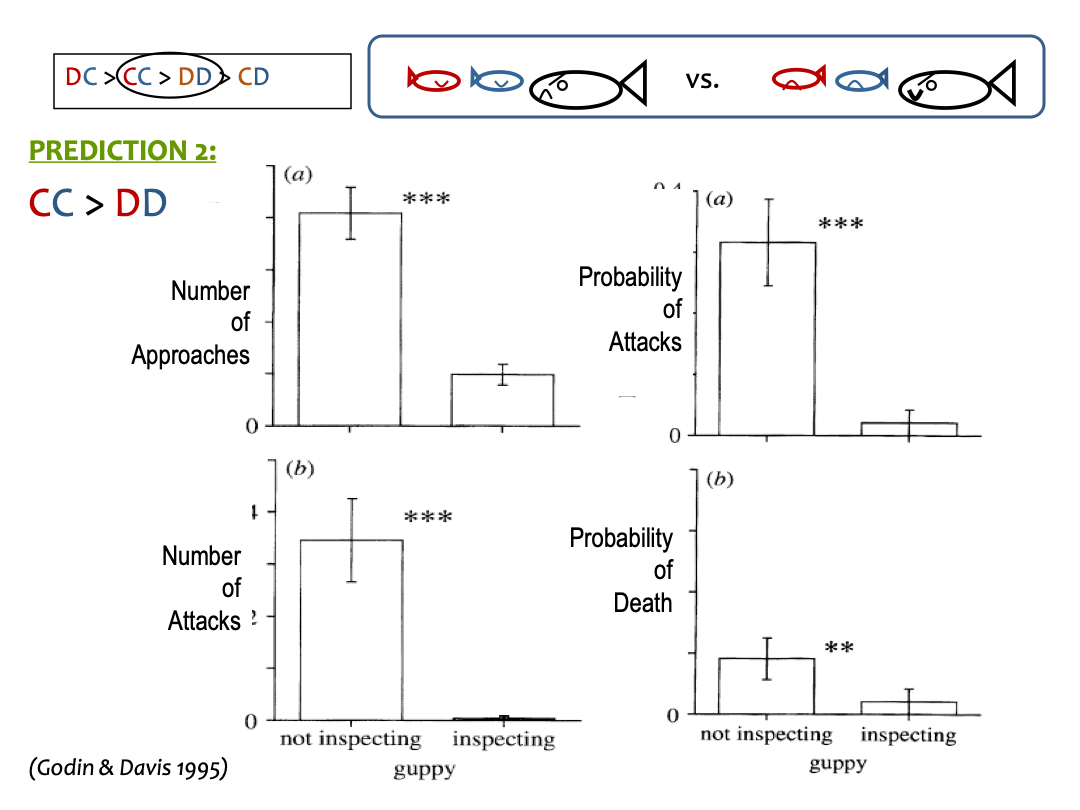
This means, the relation must be true. Low inspection means you’re less likely to be alive - it is better to defect while the other cooperates clearly. Better that you both inspect than neither at all. No-inspecting means you’re probably more likely to die.
Payoff of not being eaten comes at one lone inspector. Pay off to defector. Better you are not the one individual who is cooperating if the other is defecting.
Benefit to self via Kin / Kinship
The probability that 2 individuals share an allele that they have inherited from some common, recent ancestor. Coefficient of Relatedness = ‘r’
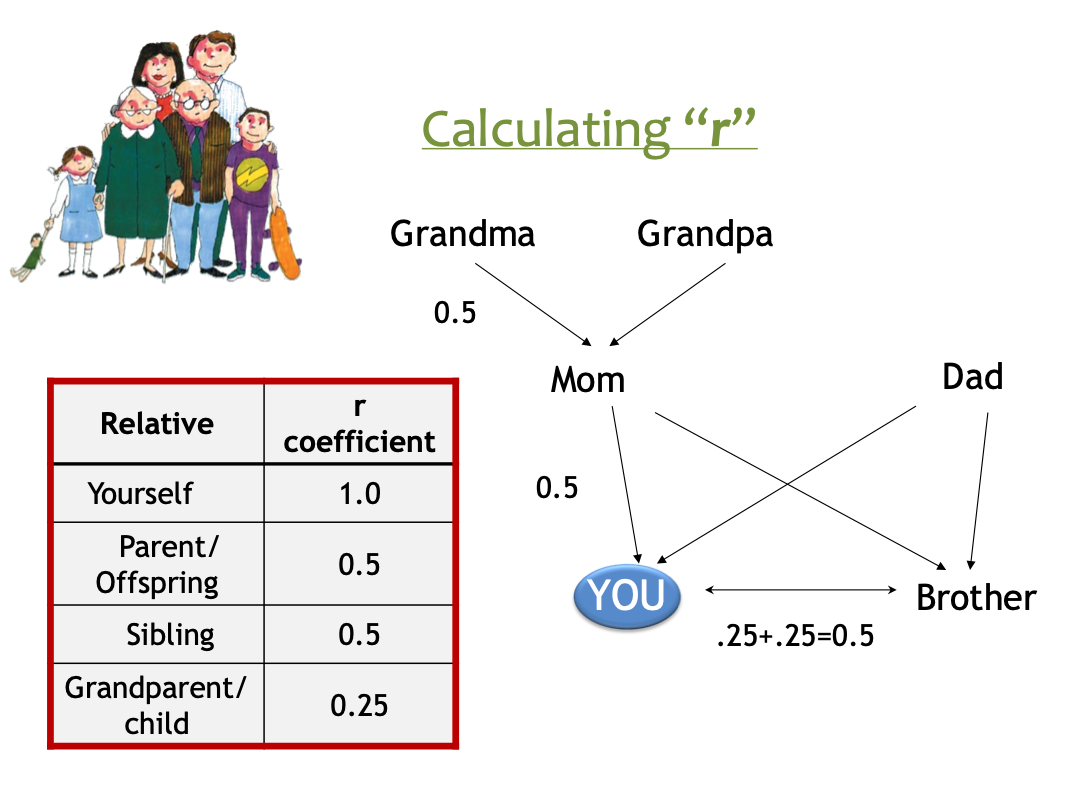
Direct fitness: the genes contributed to the next generation by an individual via personal reproduction in the bodies of surviving offspring (‘descendant kin’)
Indirect fitness: The genes contributed to the next generation gained through non-descent kin.
Inclusive fitness = direct fitness + indirect fitness
Hamilton’s rule: an individual will help out another as long as r x brec > cdon
r coefficient of relatedness, b benefit to the receiver, c cost to the donor
Once cost reaches greater than benefit greater or whatever, stop helping individual. How much are you forgoing of your own offspring in order to neglect yourself. How much is too much cost.
Cooperative breeding: sexually mature offspring may come back to help in parental nest. When helpers are removed, a lot less offspring survive. Relieving parents so they could have future offspring. Lots of habitats available. Failed to see helpers at the next island, they had their own territory. High quality started seeing helpers, medium were also seeing helpers.
Foraging: Obtaining Food vs. Being Food
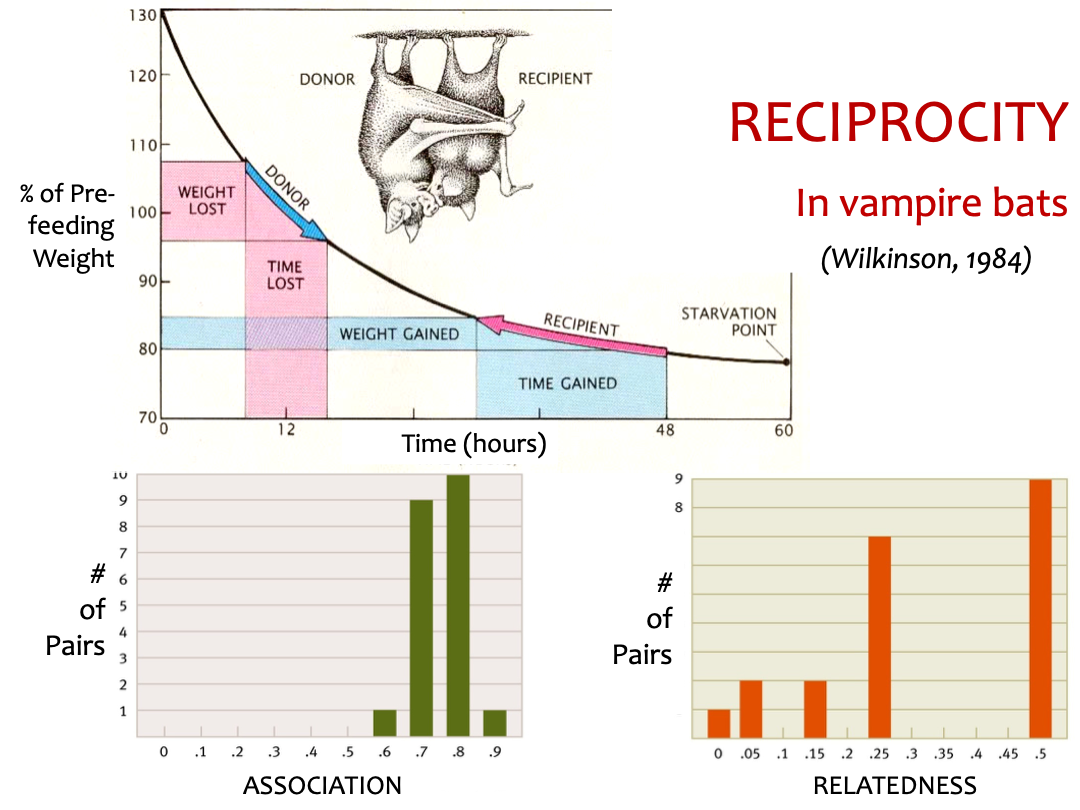
Foraging is about optimality and tradeoffs with other aspects which affect fitness. Energy expenditures, time, reproduction, kin (inclusive fitness), competition (group living), safety (predators, sexual harassment), brain power (perception, learning, etc.) - there are constraints.
Optimal Foraging Theory (OFT): used to predict the best possible solution to a problem, given a certain set of constraints.
Which foods will you eat - based on nutritional requirements and handling time.
When to move on (variability in food supply), how bad is predation
Risk-sensitive foraging: Risk-averse, risk-prone
Time & energy that could be redirected to other behaviours.
Deciding which food to eat - depends on energy value, encounter rate, handling time
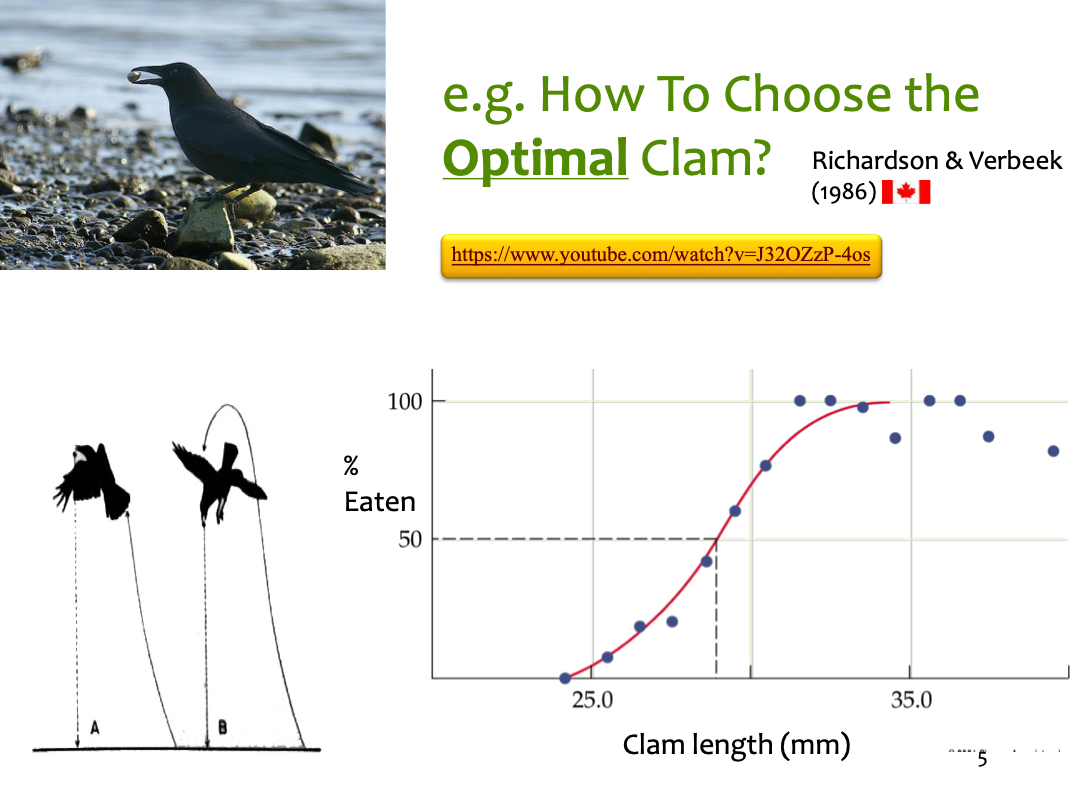
Longer clam, higher percentage of getting eaten.
Marginal value theorem (MVT): 1. Stay in current patch until marginal food intake = average rate of intake across all other patches, given the cost of getting to other patches. 2. The greater the time between patches, the longer you should stay in a patch. 3. Already poor quality, should leave quicker than if it was in a more profitable patch.
Optimal group size differs based on the mean capture of individuals per minute based on group size.
Birds are risk sensitive when it comes to foraging = they don’t carry as much over the area the move through if there’s no predators.
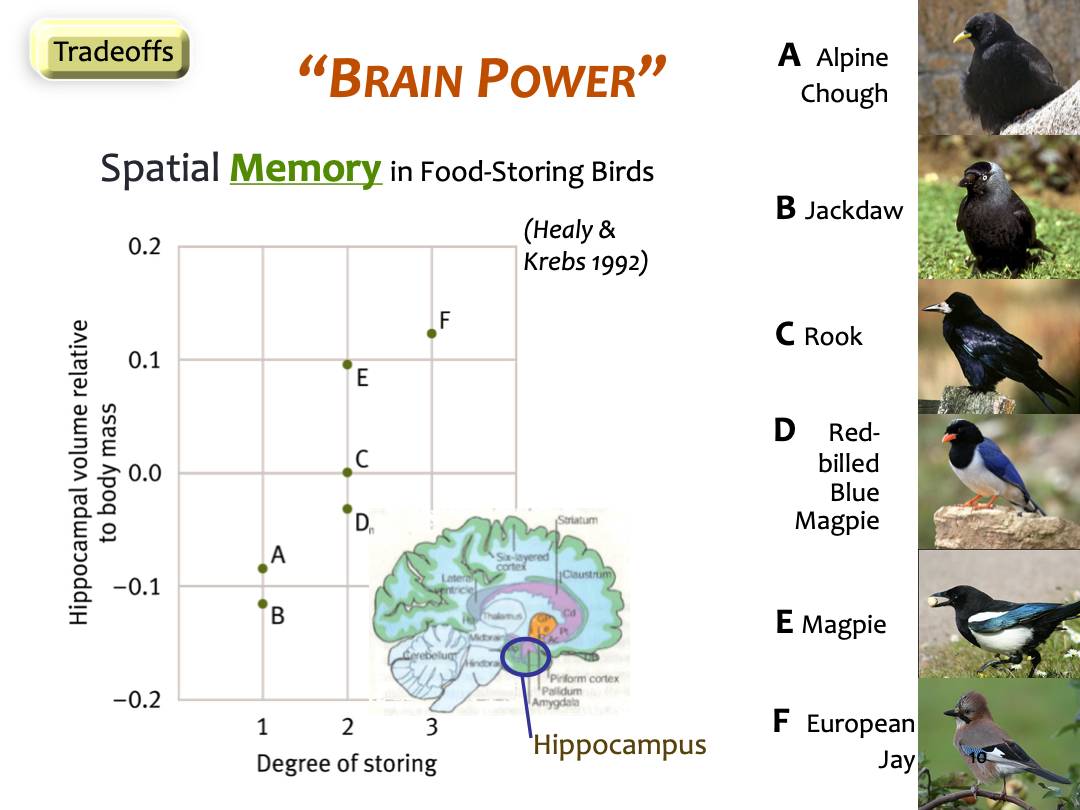
Higher hippocampal volume to body mass → higher degree of storing spatial memory.
Generalist are better at selectioning taste aversion and learning, whereas specialists struggle to stop eating poisonous individuals.
Anti-predation mechanisms
Camouflage - gazelles near brown rocks, praying mantis in grass, stick bug, chick in brown wood.
Industrial melanism: peppered moth - as buildings became gray and with industrialization, peppered moths turned from brown like wood, to white/gray like the new landscape.
Body decorating: the more dirt they covered themselves in, the closer an observer needed to be to see them. Rock Ptarmigan.
Mullerian mimicry (aposematic colouration): Species that look like in colour may benefit from the other being poisonous or dangerous. Signaling profitability.
Batesian mimicry (exploitation): Mullerian mimicry selects for this. Animals look extremely similar, pretty much identical, and are able to avoid predation because of it.
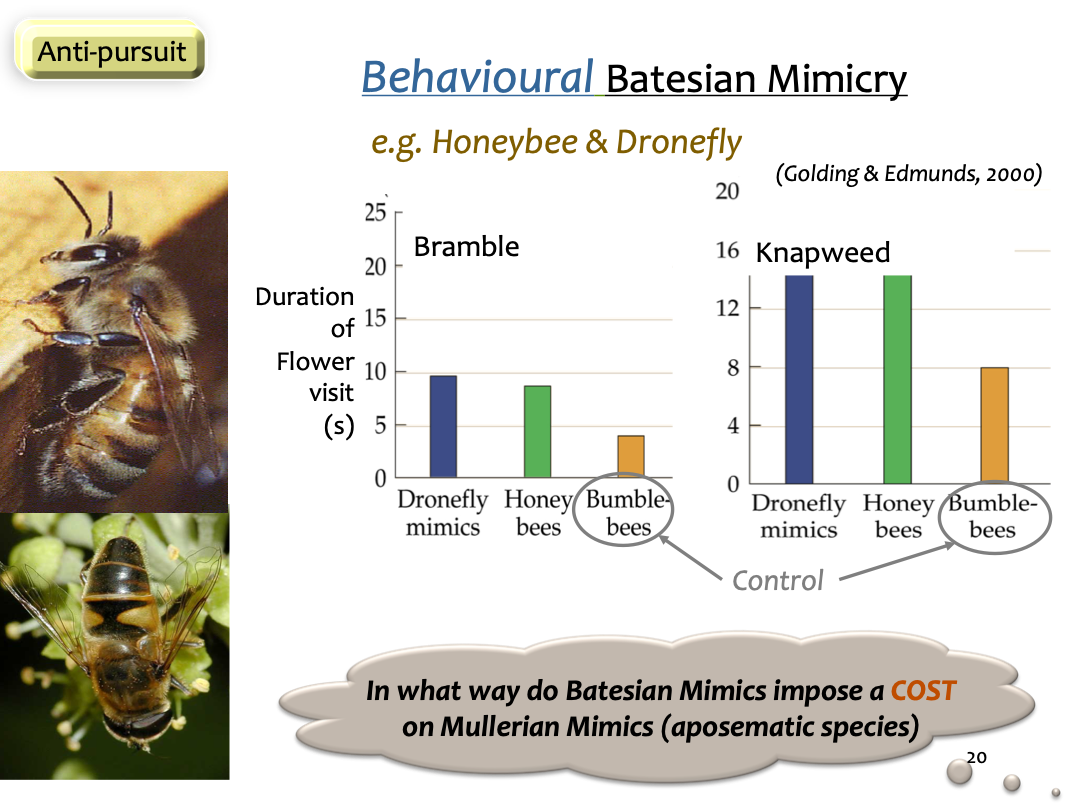
In what way do Batesian Mimics impose a cost on Mullerian Mimics (aposematic species). Honey bee Dronefly.
Control bumble bees don’t stay as long. Predators don’t learn the association of the colour being poisonous. Mullerian mimics are not going to be able to learn the poison.
General mimicry: meant to use anti-capture, not prevent or deception, it’s about making them think things. Eyes of the owl on wings scares off their predator (small birds). Eyes somewhere else distracts predator.
Vigilance: foraging in a group with many eyes - one spots, flies away, everyone follows suit. More pigeons in a flock, the less successful the goshawk is at attacking. One individual may not detect at all.
Ducks have one eye open when they sleep. Away.
Dilution effect / selfish herd: sheer numbers protects you from being eaten. With group size, predator is going to see you, with increase, decreases group size. Just sheet numbers. Where you are in the group matters - edges most vulnerable. Whirligig on the edges get more food particles though. Food deprived on outside, well-fed stay in the centre where it’s safer. It’s about risk.
Learning and Communication
Animal Learning
If innately understanding thing is easier - why do we bother learning things?
Learning: a relatively permanent change in behaviour due to experience
There is an adaptive value of learning due to environmental unpredictability. Horses are born knowing how to walk and salmon don’t have parents, they just know where to go. There are a lot of new things and changes in environment, good to know abiotic and biotic (social/conspecific) stuff.
Social learning: what to eat, where to forage, who is a predator, who to mate with. We learn a lot from others. They can teach you what to eat (smelling breath), learn where food is abundant. Who to mob, who to mate with.
Sexual conflict: Japanese quails chase and forcibly copulate / male sexual coercion.
Non-preferred males had performed more harmful behaviours than preferred males. Females may have some control in who mates with them. Females may have control over who mates with their gametes. Females prefer males that perform more aggressive individuals. They like the feather pulls.
More harmful behaviours didn’t fertilize.
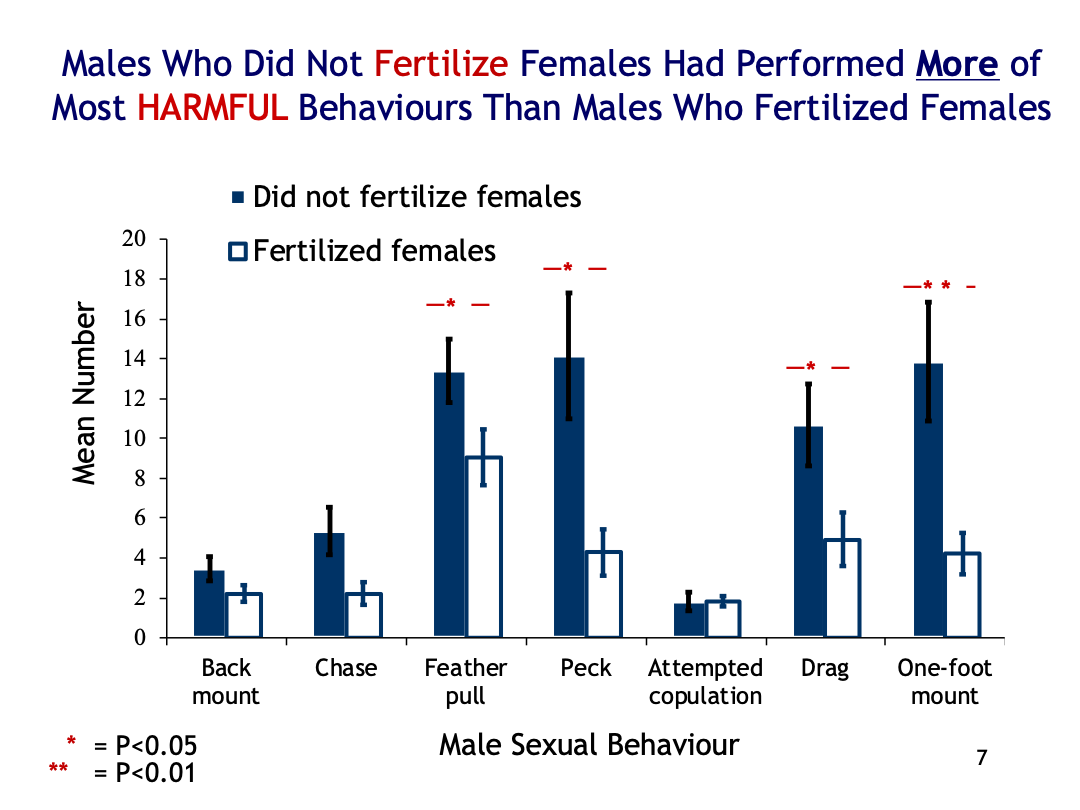
Preferred males are more likely to fertilize females than non-preferred males. These females had received same amount of copulation together.
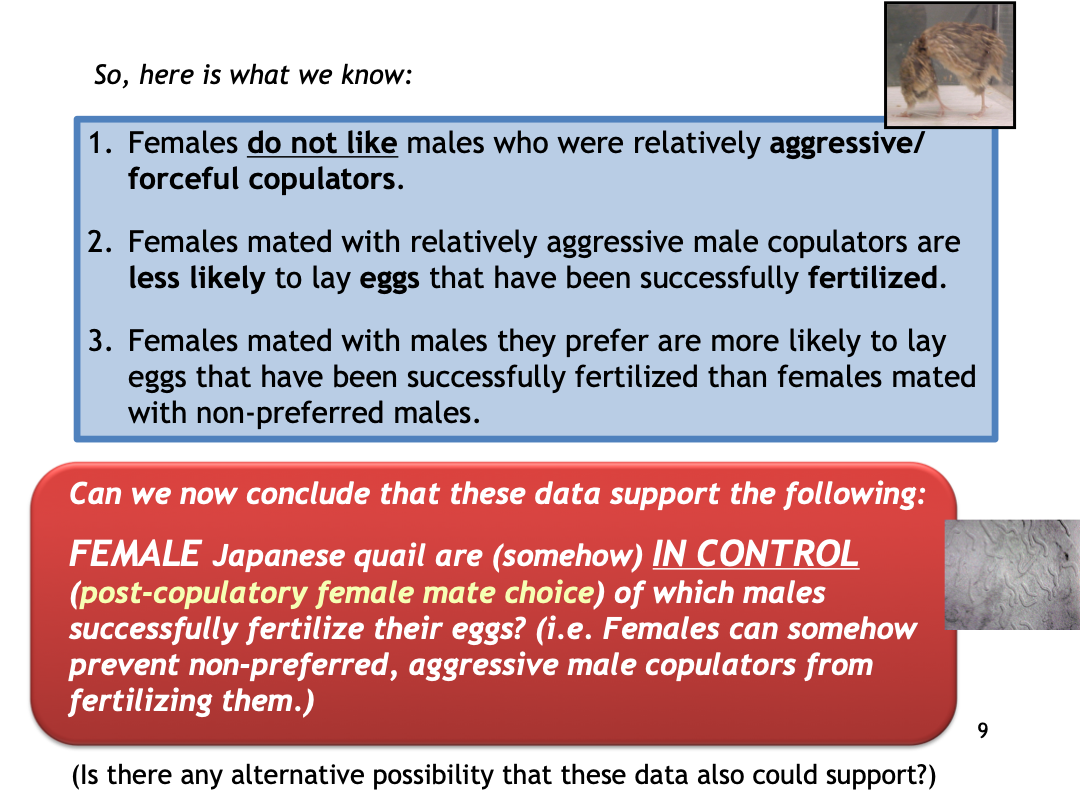
Females who are mated with males they both like. We don’t know if females are actually choosing, or if there’s something about them and their quality making them worse at fertilization.
Mate-Choice Copying: the mate choice of one individual influences the mate choice of another (same-sex) individual. Expected when cost associated with mate selection are high. Females differ in ability to choose good males. Information from other females helps you avoid interacting with a male, and just pick if a female likes a male. Female has already assessed the male.
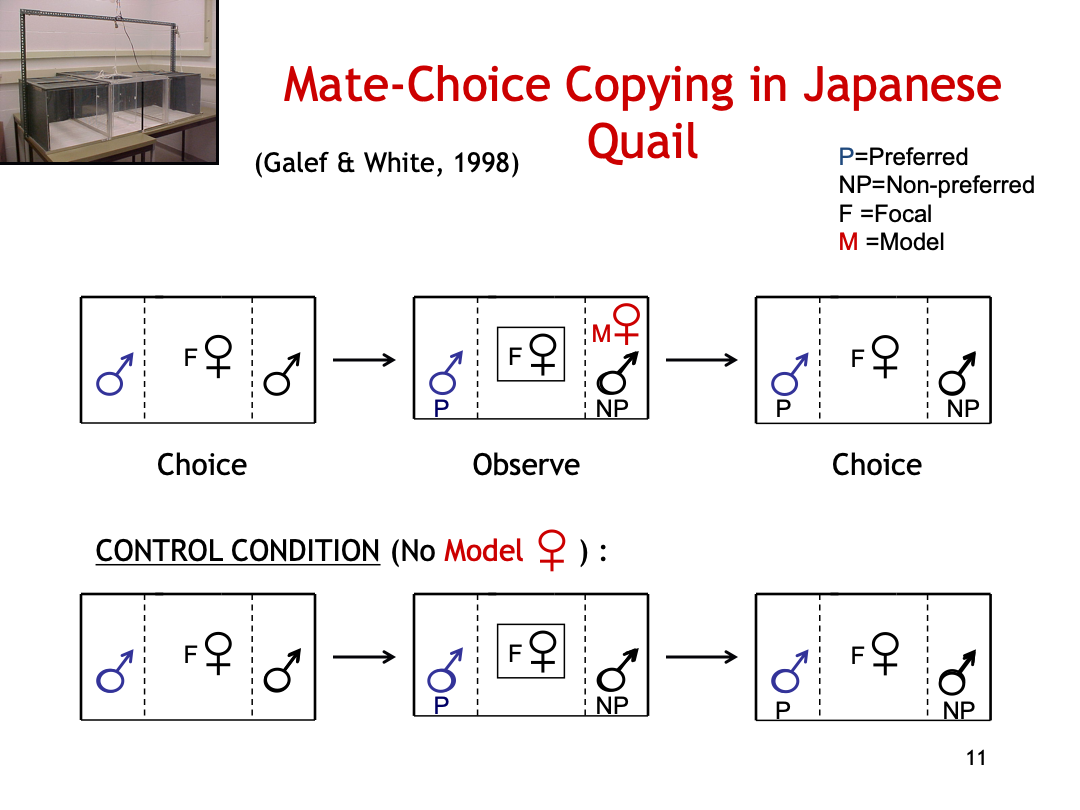
Females increase their preference for males observed with other females. Difference in time of choice tests. Significantly increases time she stays with him after she’s seen a model female with him. Males do they opposite.
This may help with manipulating female preferences. Does it chance probability of fertilization.
One male becomes preferred, one becomes non-preferred. We then pair with males and females and now they switch who preferred male is.
Increasing female preference increases probability of fertilization.
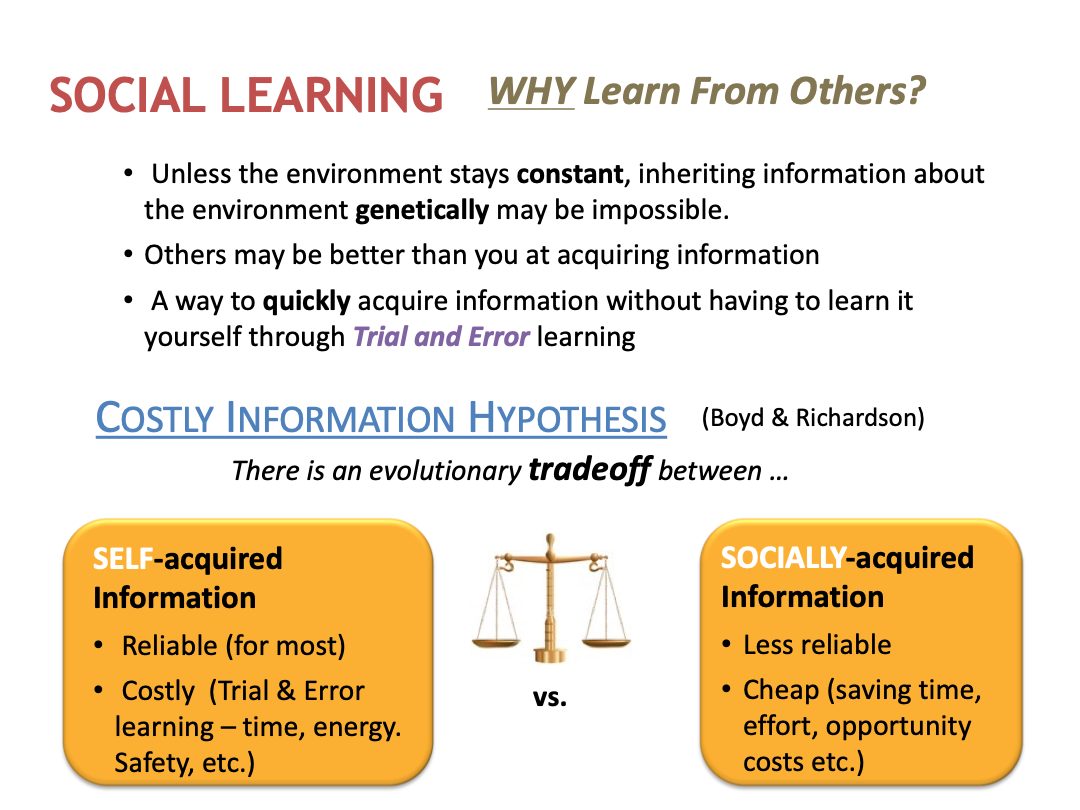
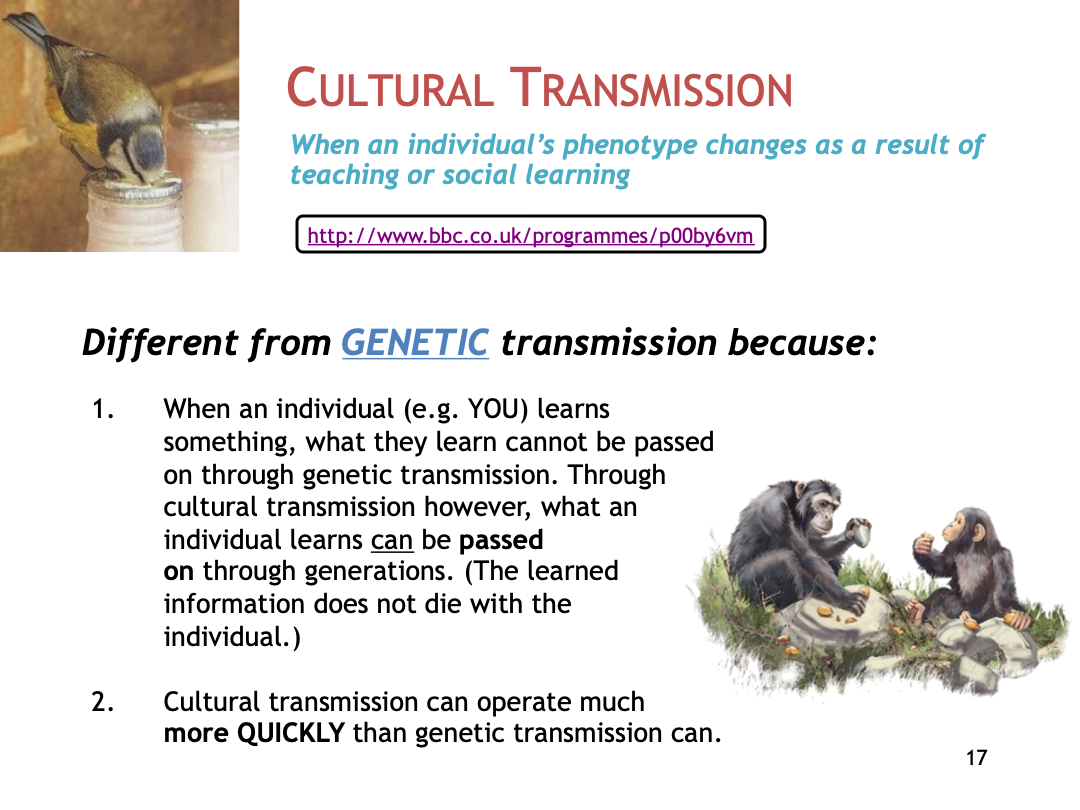
When there is a phenotype change as a result of social or cultural learning. Birds and milk bottles - just watching others do it and started doing it.
Zebra finches only have a specific, complex neural centre in their brain during breeding season. Change in brain space region and matter. Quite large. Changes and shrinks in size.
Costly neutral investment: hippocampus has different behaviour. Males going around and finding females. Males of polygynous have a big hippocampal body, significantly works with us.
Evolution of learning is a selective association, can’t associate just anything. More likely to come across some association more than other. Flash and pain, taste of food and sickness. When they went to drink - they’d flash and get shocked. Another group got a flash of light and slight poison in the water. Tastes foul/sour, they don’t drink it. Mice are only good at learning what mice are doing. When you pair sour water and sickness they’re quick with it. Very bad at learning not to drink regular tasting water. Evolutionary history matter.
Once chicks hatch, they’re more likely to want different parents than their own species. Still not hatched - they learn a passcode. Young and eggs learn a certain way to stop from parasites coming in. Young cuttlefish. Learn a passcode. Young and eggs learn a certain way to stop from parasites coming in. Young cuttlefish - learning happens earlier than we thought.
Learning can begin earlier than previously thought.
Animal Communication
When information is transferred from signaler to receiver
Contexts - in what ways does it work or how. Communicate about how stuff is working. Auto communicating is like bouncing sound off of the wall.
Territorial defence, conflict resolution, mate attraction, courtship signals, environmental contexts, social integration, parent-offspring interactions, “auto-communication”
Modes - Not much visual communication in dense areas. Colour and light not good for far distance. Electrical or chemical better in these cases.
auditory, visual, vibrational, chemical, electrical.
The Physical Environment - selection pressure.
Sender-necessary costs: selection pressures. Cichlids have good red spectrum, so guppies are in the blue spectrum to avoid being eaten. They are communicating visually. Energy, conspicuousness (auditory, olfactory, visual), time lost, conflict with original function. Co-opted signal.
Look at this random thing, I must be great. Long tail was originally meant to help with flying. Colour is very expensive.
Evolutionary origin vs. current adaptive value of a signal. Pseudopenis.
Visual: body size, access to pigments. Auditory: stridulation, vocal, body size. Chemical: not many contraints.
Body size in toads. You have to be a certain body size to make the good croak (lowest, deepest). Only can make it if you can.
Signals can be cooperative or manipulative. You can be big and bold, like a sales person trying to sell a pitch. Exaggerated display, like look at me I’m hurt. You can also be subtle, inconspicuous (bc. of costs involved) - conspiratorial whispers. Interest of signaler doesn’t always equal interest of receiver
Dishonest communication: when information is transferred from signaler to receiver
Illegitimate sender / deception
Conflict of interest between receiver and sender. Sender cheats on receiver.
Competitors, mating pair, predator/prey.
Evolutionary arms race - better the receiver gets, that is when host wins. Parasite will get better and better.
Sensory exploitation of signal receiver by signaler: Deceive by taking advantage of a trait they already have. Red dots don’t resemble eggs. Attracts females to mate with them. Not trying, it just so happens to attract more females.
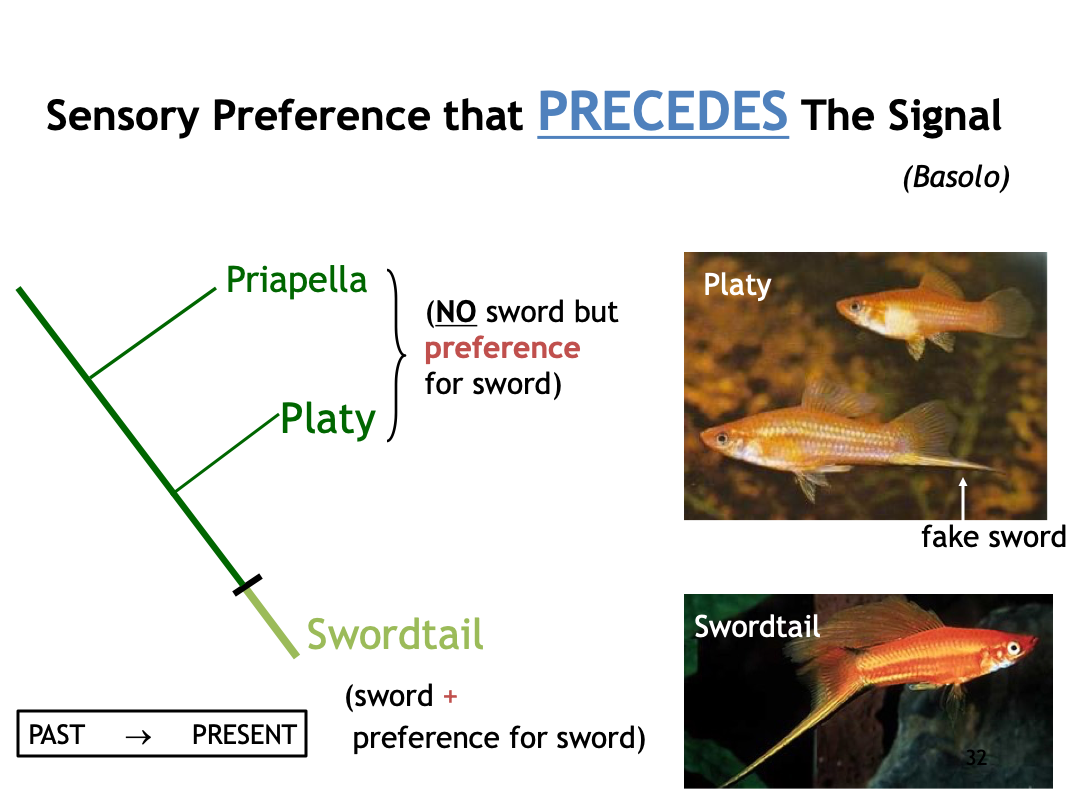
Exists but is hidden until something comes in to exhibit a response. Don’t prefer males, but if you add a sword, it does.
How does deception evolve - novel environment or exploitation. Photuris females are huge, they deceive males. Novel - too recent to develop detection in a population. Exploitation - it benefits to signal and signal back. Hardly happens that it’s femme fatale.
Deception selects for honest signaling, making it impossible or difficult to fake. Deception is absent, meaning individuals only respond to signallers that cannot be faked. Only pay attention to non-fakes. Can’t fake a deep croak for example or deep roar.
Illegitimate receiver / eavesdropping - not meant to hear, use to their advantage.
Often uses the information from signal to the fitness detriment of signaler and intended receiver - on mates, on prey, on rivals
Whines and chucks. Dilution effect. The more you call, the more likely to have a predator called in too / eavesdrop.
Evolutionary Psychology
Adaptationist, selectionist: the mind is a set of information-processing machines with costly decision-making mechanisms that evolved through natural selection to solve adaptive problems humans have faced/face.
A way of thinking about human information, processing, decision making and behaviour that generates testable predictions
Contextual clues → brain (evolved psychological mechanisms like decisions rules, infor, and processing devices) → Behaviour
Common misconceptions
Humans behave with the purpose of increasing their fitness
We don’t donate money for fitness, we find non-human animals cute, we do things because they feel good (proximate explanation). I like videos games but I can’t actually reproduce with the characters.
All human behaviour exhibited is adaptive
Masturbation, adoption, sex for pleasure (birth control), excess aggression. We do it because it feels good.
Sometimes a (maladaptive) by-product of mechanisms that generally serve us well - sometimes doesn’t serve current humans well
Environment of Evolutionary Adaptedness (E.E.A.): Males and females lived in nomadic tribes, hunted, gathered, had offspring. Cooperation between individuals mattered because you lived in groups. Selection pressures for feeding and defending yourself mattered. Taking care of offspring and mating. Caused the evolution of traits today.
What is “adaptive” is good, right, and meant-to-be
Sexual coercion, rape, racism, classism. A lot of critics of evolutionary psychology. Evolutionary psychology explains behaviour, not justifies it. Things we see or say are not necessarily evolved because they’re the right thing.
Characteristics are developmentally flexible & conditional as a collaboration between genes & environment
Adaptationist Perspective
Study: behavioural genetics, male & female, intra-sexual competition, inter-sexual mate choice, sexual conflict, parental care, kinship, social behaviour, defense, eating, communication, learning
Twin studies who help with discovering whether behaviour is due to both genes and behaviours. Long-lost siblings and test. Relative genetics and effects on their behaviours. Cliff swallows, natural experiment that happened. Adoptive parents, birth parents who found later on, monozygotic twins, and dizygotic twins. Highest correlation when they grew up together and were monozygotic.
Males have a greater difference in projected number of sexual partners - males more than females.
Males are more likely to choose sexual infidelity when given options about emotional maturity and sexual maturity - what helps them more
Young Male Syndrome: young males should exhibit more “risk-taking”. Young males should be the most involved in the violent crimes. Homicide statistics state young males will be both the majority of offenders & victims. Could be an intrasexual competition.
Intra-sex competition: Sperm competition between males. Amount of ejaculate from males at a sperm bank. What is a percentage of time spent from last time you were without your partner. More time spent apart - more sperm per ejaculate. Sperm competition. They have to risk it.
Inter-sex mate choice: sex differences in preferences and offers made to members of the opposite sex. Good looks are meant to symbolize youth and fertility.
Feminized males are preferred more by females when non-ovulating. Ovulating females prefer less feminization.
Major histocompatibility complex - MHC
Pathogen defense, T-shirt sniffing
When females take oral contraceptives they prefer a similar sent to themselves, otherwise they prefer dissimilar MHC.
Sexual conflict: Applying an evolutionary perspective provides information which may lead to more effective solutions. Equally as likely for males to kill a spouse and a non-related individual.
Parental care: They’re trying to reassure the father when they say you look like your father. They feel productive doing that.
Trivers-Willard Hypothesis - Eat a lot of cereal, have a high percentage of boys.
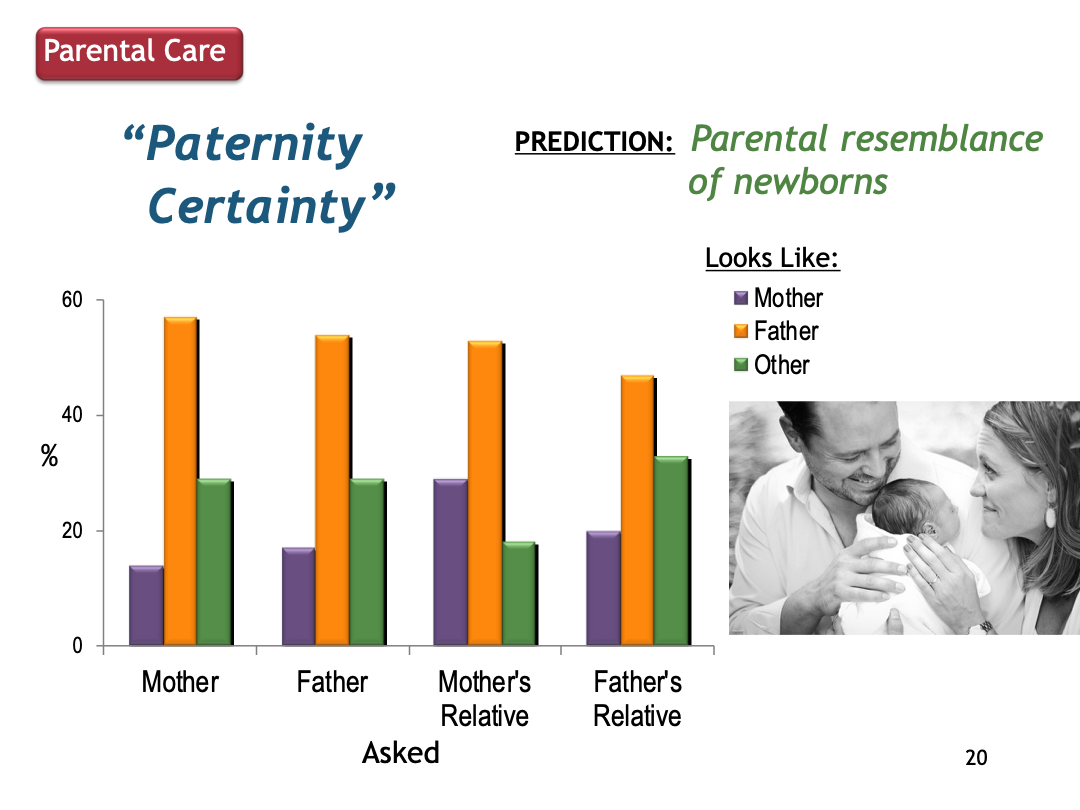
Kinship: When faces are morphed with their own, people were found to be more cooperative. Not knowing your face was morphed into it.
Sociality: Human altruism - but we care about reputation. Just a picture of eyes on a donation box means people donated more money than if there was just flowers.
Feeding: spices help with antimicrobial activity, hotter climate, more spices.
Learning: humans show mate choice copying after observing real mate choices. Showed males with a male being disliked by a female vs. being liked by a female. Change in rating over time - not interested, they decrease if they wanted a long term relationship. Interested in the male increased their preference for the male. They added to their rating.
Tutorial Concepts
Honest Signaling
“Game theory”: models incorporating various aspects of natural history and assumption about the biology of study species. Contests between rivals are typically won by whose larger, better physical conditions, or who has more experience in contests.
Resource Holding Potential: Winner of contests between rivals has a higher RHP. May relate to experience
War of Attrition models:
An individual is assumed to compete with another only up to a certain level, and then retreats from the contest. Neither individual knows how far the other is will or able to go. The contest simply ends when one of the contestants reaches their own maximum level of investment in the contest.
It is evolutionarily costly for an individual to engage in a fight with an individual assessed as being lower RHP, as well as to surrender a valuable resource to an opponent mistakenly assessed as being of higher RHP.
Contest resolution can be subject to bluffing behaviour
Honest signals: convey to an opponent an accurate measure of RHP. Physiological pathway or morphological appearance. Truly reflect the ability of an individual to win a contest over a resource. “Cheaters” cannot produce these signals.
Group Defence
Benefits may outweigh costs. Increased competition and risk of disease are costly, but foraging advantages and anti-predator benefits may outweigh.
Dilution effect: an individual’s chance of being captured decreases as group size increases, often because the predator takes only a single or a limited number of prey on each attack.
The probability of capture for each individual prey animal as a function of group size. If this declines as a group increases, dilution effect is in operation.
Confusion effect: predators find it difficult to focus on one prey and with all moving in different directions and lots of noise. Difficult to focus on stimuli coming from one prey. Has been shown to occur in fish escaping from predators such as other fish or squid.
Percentage of attacks by the predator that result at least one prey captured. Function of group size (percent of successful hunts). If this declines as group size increases, a confusion effect will have been in operation.
Odd prey effect: any prey that differs in a conspicuous way from the others in its group is more likely to draw a predator’s notice, leading to an increased chance of it being attacked and captured.
Optimal Foraging Strategy
Solitary foraging (pair) is better with widely dispersed food
Foraging in flocks is better with clumped food (“patchy”) distribution.
